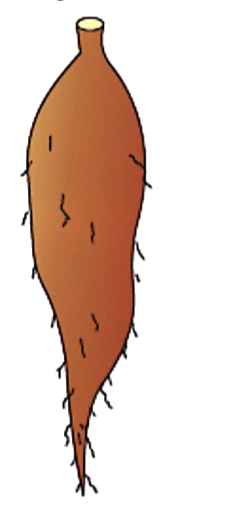Select the correct statements
(A) From the region of elongation, some of the epidermal cell for root hairs
(B) Pneumatophores are seen in Rhizophora
(C) Adventitous roots are seen in the Banyan tree
(D) Maize and sugarcane have prop roots
A and D
A,C and D
C and D
B and C
The correct Answer is:D
To solve the question, we need to evaluate each statement one by one to determine if they are correct or incorrect.
1. Evaluate Statement (A):
- Statement: "From the region of elongation, some of the epidermal cells form root hairs."
- Analysis: Root hairs actually develop from the region of maturation, not the region of elongation. The region of elongation is primarily where the cells divide and the root grows longer. Therefore, this statement is incorrect.
2. Evaluate Statement (B):
- Statement: "Pneumatophores are seen in Rhizophora."
- Analysis: Pneumatophores are specialized aerial roots that help in gas exchange and are indeed found in the Rhizophora species (mangroves). They grow upwards and have openings (lenticels) for oxygen intake. Thus, this statement is correct.
3. Evaluate Statement (C):
- Statement: "Adventitious roots are seen in the Banyan tree."
- Analysis: Adventitious roots are roots that grow from non-root tissues, such as stems or leaves. Banyan trees produce aerial roots that grow down from their branches into the soil. Therefore, this statement is correct.
4. Evaluate Statement (D):
- Statement: "Maize and sugarcane have prop roots."
- Analysis: Maize and sugarcane actually have fibrous roots, not prop roots. Prop roots are typically associated with plants like mangroves and certain types of figs. Therefore, this statement is incorrect.
Conclusion:
The correct statements are:
- (B) Pneumatophores are seen in Rhizophora.
- (C) Adventitious roots are seen in the Banyan tree.
Final Answer:
The correct options are (B) and (C).
---
- Statement: "From the region of elongation, some of the epidermal cells form root hairs."
- Analysis: Root hairs actually develop from the region of maturation, not the region of elongation. The region of elongation is primarily where the cells divide and the root grows longer. Therefore, this statement is incorrect.
- Statement: "Pneumatophores are seen in Rhizophora."
- Analysis: Pneumatophores are specialized aerial roots that help in gas exchange and are indeed found in the Rhizophora species (mangroves). They grow upwards and have openings (lenticels) for oxygen intake. Thus, this statement is correct.
- Statement: "Adventitious roots are seen in the Banyan tree."
- Analysis: Adventitious roots are roots that grow from non-root tissues, such as stems or leaves. Banyan trees produce aerial roots that grow down from their branches into the soil. Therefore, this statement is correct.
- Statement: "Maize and sugarcane have prop roots."
- Analysis: Maize and sugarcane actually have fibrous roots, not prop roots. Prop roots are typically associated with plants like mangroves and certain types of figs. Therefore, this statement is incorrect.
The correct statements are:
- (B) Pneumatophores are seen in Rhizophora.
- (C) Adventitious roots are seen in the Banyan tree.
The correct options are (B) and (C).
Similar Questions
Consider the following statements reagarding the root system of angiosperms
I. In monocots, the Fibrous root system arises from base of stem. II Region of elongation is called root hair zone . III In sweet potato, adventitious roots get swollen and store food IV. Stem of Maize and Sugaracane have supporting roots called prop roots
View SolutionWhich of the following statements is/are incorrect regarding roots?
(i) In Rhizophora, pneumatophores are found.
(ii) Tap roots of carrot, turnip and adventitious roots of sweet potato, get swollen and store food.
(iii) The stems of maize and sugarcane have supporting prop roots coming out of the lower nodes of the stem.
View SolutionSelect the incorrect statement from the following.
(a) Rhizobium multiply and colonises the surroundings of roots and gets attached to epidermal and root hair cell.
(b) Successful infection of the root hair causes it to curl .
(c) The nodule establishes a direct Vascular connection with the host .
(d) Infection thread carries the bacteria to xylem and phloem .
View SolutionSupporting roots of maize stem, which arise from the lower nodes are called
(a) Pneumatophores
(b) Prop roots
(c) Stilt roots
(d) Contractile roots
View SolutionIn Sonneratia many roots come out of the substratum and grow vertically upwards. They are
(a) Pneumatophores
(b) Prop roots
(c) Stilt roots
(d) None of the above
View SolutionSelect the correct statements from the given
(a) Nitrogenase is heterodimeric protein.
(b) Root hairs curl by action of nitrogenase and plant nod factors.
(c ) During symbiotic N2 fixation ATP is provided by legumes plant.
View SolutionSelect true statements -
(A) Phloem fibres are generally absent in the primary phloem.
(B) Root hairs help in absorption of water and minerals from the soil
(c ) Trichome help in preventing water loss due to transpiration.
View SolutionSelect correct statements from the following:
a. In the majority of the dicotyledonous plants, the direct elongation
of the radicle leads to the formation of the primary root.
b. In monocotyledonous plants, the primary root is short-lived and is replaced by a large number of roots. These roots originate from the lowermost node of the stem and constitute the fibrous root system.
c. Adventitious roots are found in Monstera and banyan tree.
d. The fibrous root system is found in wheat and mustard plants.
View SolutionWhich kind of modification is seen in the given diagram?

(a) Tap root for storage
(b) Adventitious roots for supports
(c) Adventitious root for storage
(d) Tap root for respiration
View SolutionRead the following five statements (A to E) and select the option with all correct statement
(A) Mosses and Lichens are the first organisms to colonise a bare rock.
(B) Seloginella is a homopourous pteridophyte.
(C) Coralloid roots in Cycas have VAM.
(D) Main plant body in bryophytes is gametophytic whereas in pteridophytes it is sporophytic.
(E) In Gymnoperms, male and female gametophytes are present within sporangla located on sporophyte.
View Solution